Adding Reviewers to the Peer Review Process
Why Adding Reviewers is Important
The peer review process is a cornerstone of maintaining academic quality and integrity. Assigning expert reviewers ensures that each manuscript meets the journal's standards before publication. JMS simplifies the task of managing and adding reviewers, making it easy to ensure that the review process is thorough and efficient.
Steps to Add Reviewers
-
To assign reviewers, Go to all reviews
-
Click on add reviewer
-
If no reviewers are currently assigned to the journal, you’ll see the message: "No reviewers have been assigned to this journal yet – Click here to add reviewers." This link will direct you to the Add Reviewer page.

Adding Reviewers by Email
If the reviewer is already registered in the system, you can simply add them by typing their email address in the Add User field. JMS will auto-populate suggestions based on registered users.
- If the email address does not match an existing user, you can invite them to the platform.
Inviting New Reviewers
- For unregistered reviewers, click Invite User. An invitation link will be sent to their email address. Refer Inviting New Reviewers
- Once they accept the invitation, they will officially become part of the JMS system as a reviewer.
All actions performed in JMS, such as adding reviewers or making editorial decisions, trigger automated email notifications to the concerned parties, keeping everyone informed of updates in real time.
Add Reviewer
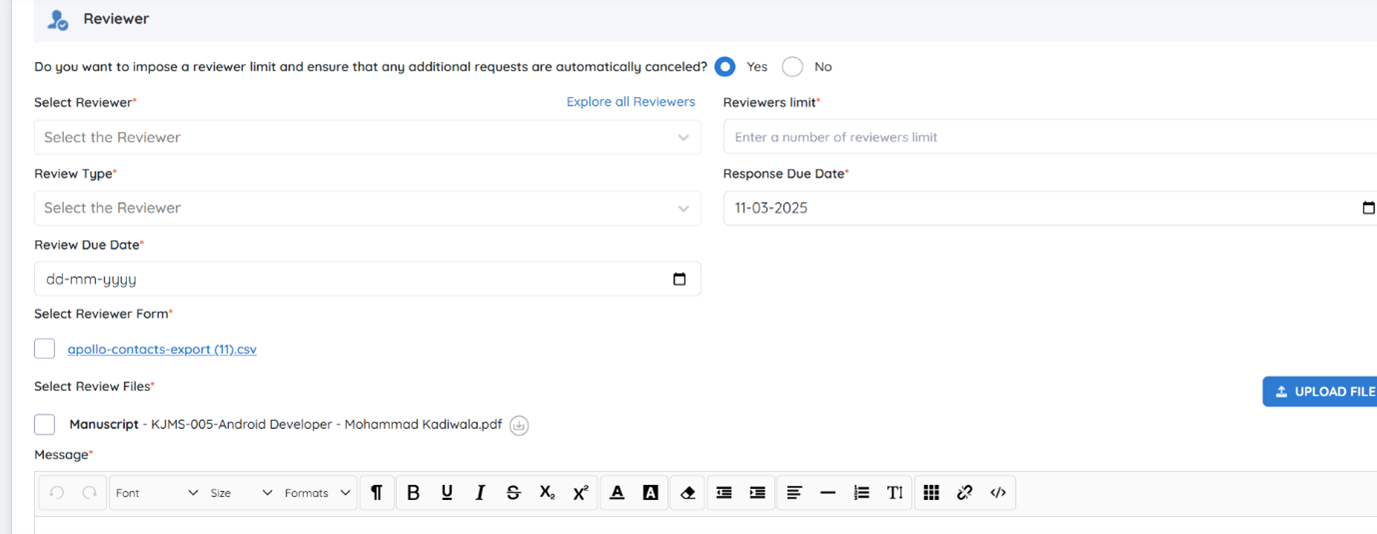
Step 1: Click "Add Reviewer"
-
On all reviews screen, click the “+Add Reviewer” button.

-
A dropdown will appear with two options:
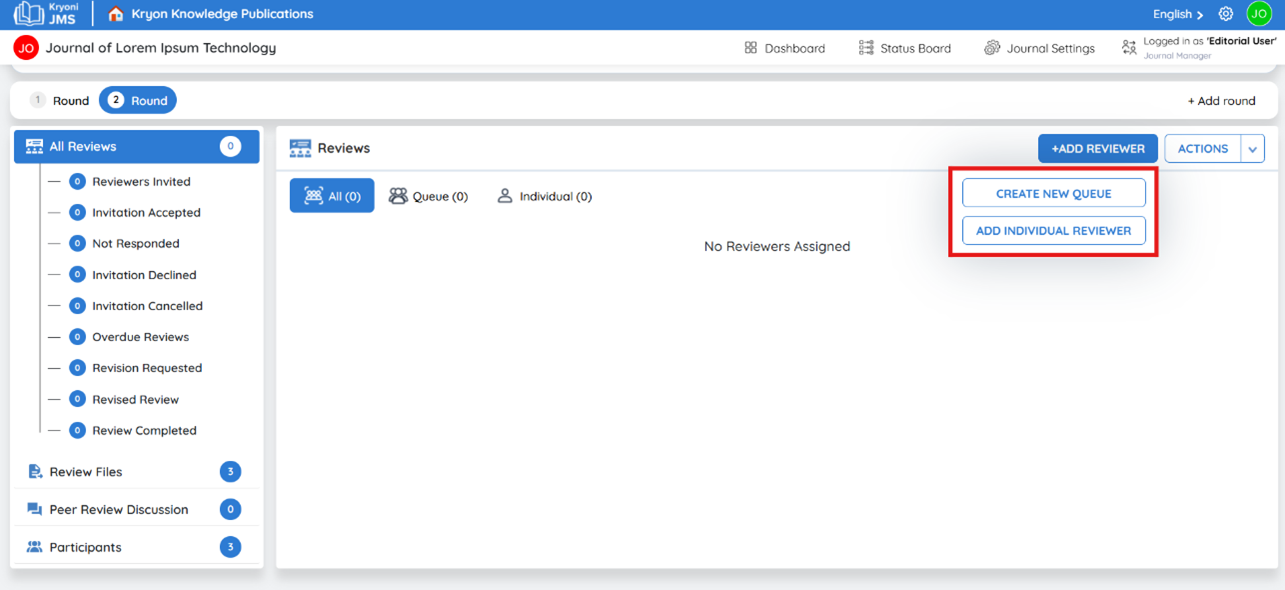
- Create New Queue – Used to initiate a batch-based or phase-wise review.
- Add Individual Reviewer – Used to directly assign a specific reviewer to the manuscript.
Let’s first explore Option 1: Creating a New Queue
-
Select “Create New Queue” from the dropdown
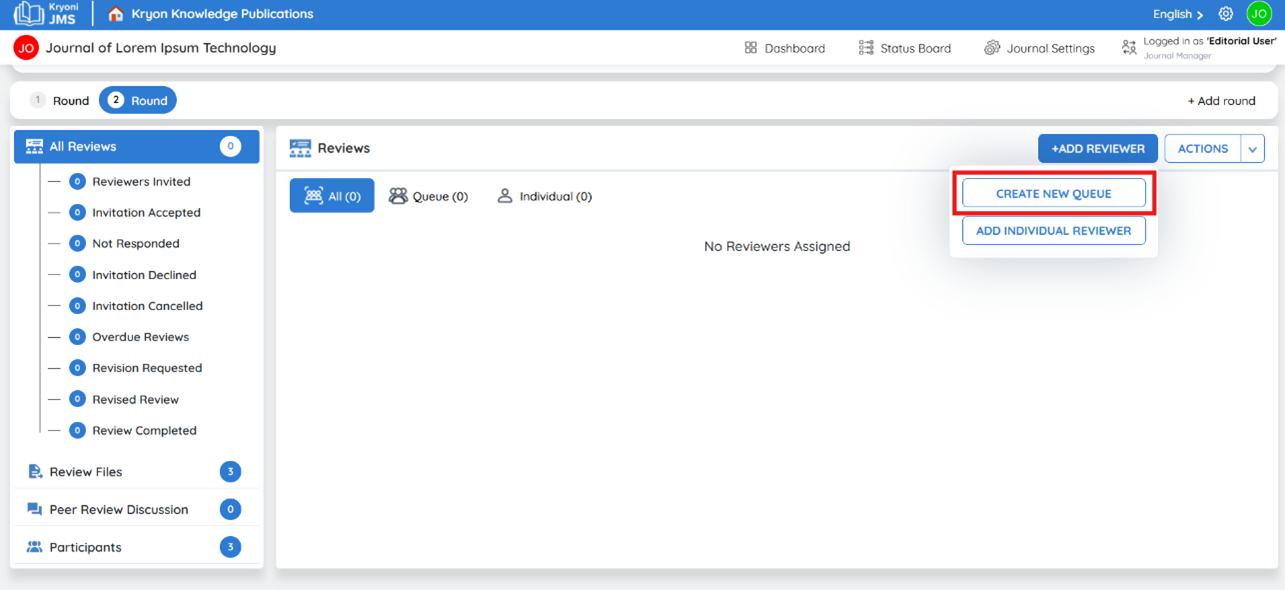
This opens the setup for a new review queue.
Step 2: Setting a Reviewer Limit

Reviewer Limit allows you to define the maximum number of reviewers required for a manuscript. Once that number of reviewers accepts the invitation, all remaining pending invitations will be automatically cancelled.
Example
If the limit is set to 2 and you invite 5 reviewers:
- Once 2 reviewers accept, the system will automatically cancel invitations sent to the remaining 3.
- This helps maintain clarity and control without requiring manual intervention.
Use Case: Streamlining Peer Review with Reviewer Limits
Use Case
Managing the review process for a research paper titled “AI in Healthcare”. Dr. Smith, a journal editor, wishes to assign reviewers while avoiding unnecessary follow-ups.
Steps Taken
1. Send Invitations
- Dr. Smith invites four reviewers: Dr. Adams, Dr. Lee, Dr. Patel, and Dr. Johnson.
2. Automated Reviewer Assignment
- For example: Dr. Adams and Dr. Lee accept first.
- The system automatically cancels pending invitations to Dr. Patel and Dr. Johnson.
Outcome
- The manuscript proceeds with two confirmed reviewers.
- The editorial team does not need to manually track or cancel excess invitations.
Why Use the Reviewer Limit?
- Prevents Over-Assignment – Avoids redundant or excessive reviewer engagement.
- Saves Time – Reduces the need for manual cancellation of pending invites.
- Ensures Efficiency – Keeps the peer review process clean, controlled, and timely.
Step 3: Select a reviewer from the list
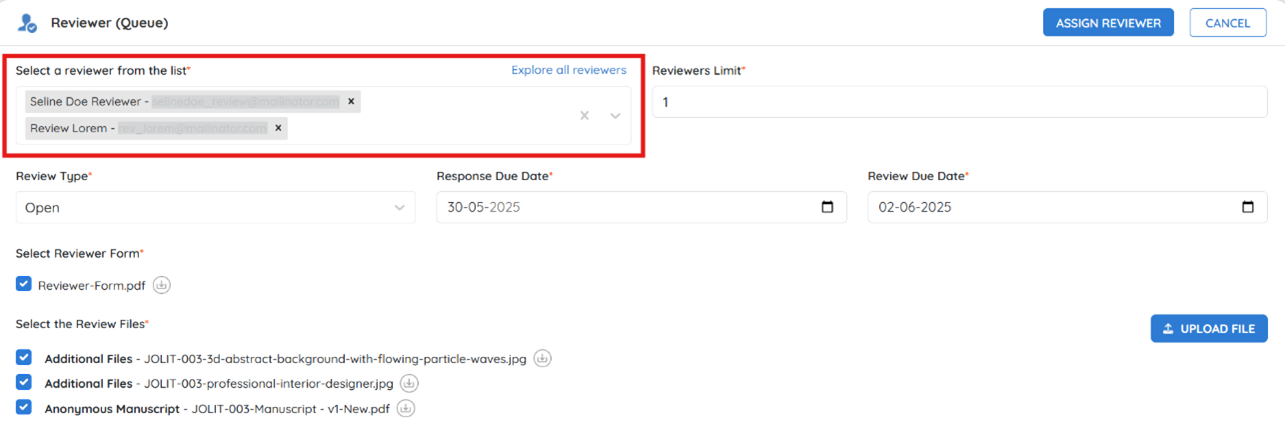
Each reviewer listed includes a summary of their profile and activity to help you make informed decisions.
Key Reviewer Information Displayed
- Keywords: Areas of expertise relevant to the submission.
Review Status Tags
- Invited – Number of pending invitations sent.
- Pending – Reviews awaiting response or in progress.
- Completed – Successfully completed reviews.
- Declined – Number of times the reviewer declined an invitation.
Explore All Reviewers
Click “Explore All Reviewers” to access the full directory of reviewers registered in your Journal Management System (JMS).

Each reviewer profile includes:
Reviewer Expertise
A detailed breakdown of their knowledge domains and specialties.
Reviewer Statistics
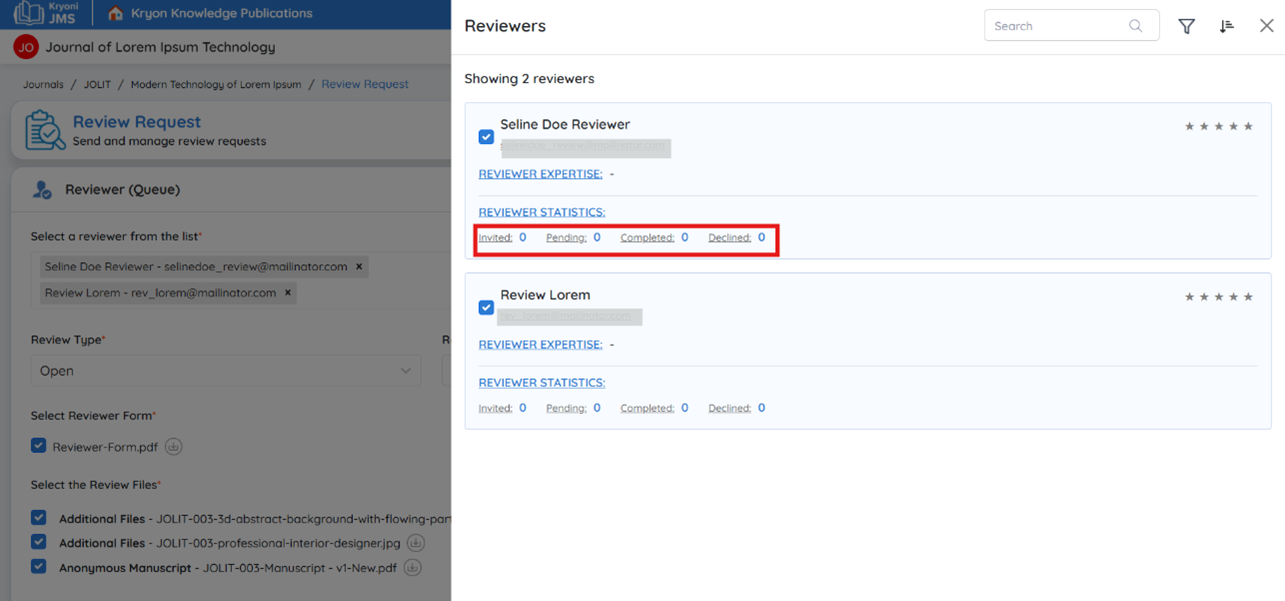
These stats provide insights into a reviewer’s engagement and reliability:
- Invited – Total invitations received.
- Declined – Times the reviewer declined to participate.
- In Progress – Active review assignments.
- Completed – Number of completed reviews.
These metrics help you assess a reviewer’s workload, reliability, and expertise—allowing you to make balanced assignments.
Filter Options
Use filters to narrow down your reviewer search based on specific criteria:
- Expertise: Filter reviewers based on their areas of expertise.
- Rating: Select a reviewer based on their rating for a particular submission.
- Availability: Identify reviewers currently available or not.
Step 4: Assign the Reviewer
After evaluating the reviewer’s profile and filtering based on your needs:
- Select the most appropriate reviewer(s) from the list.
- Click “Apply” to finalize the reviewer assignment.
Step 5: Choose Review Type

Select the appropriate Review Type based on the journal’s review process.
Step 6: Set Important Deadlines
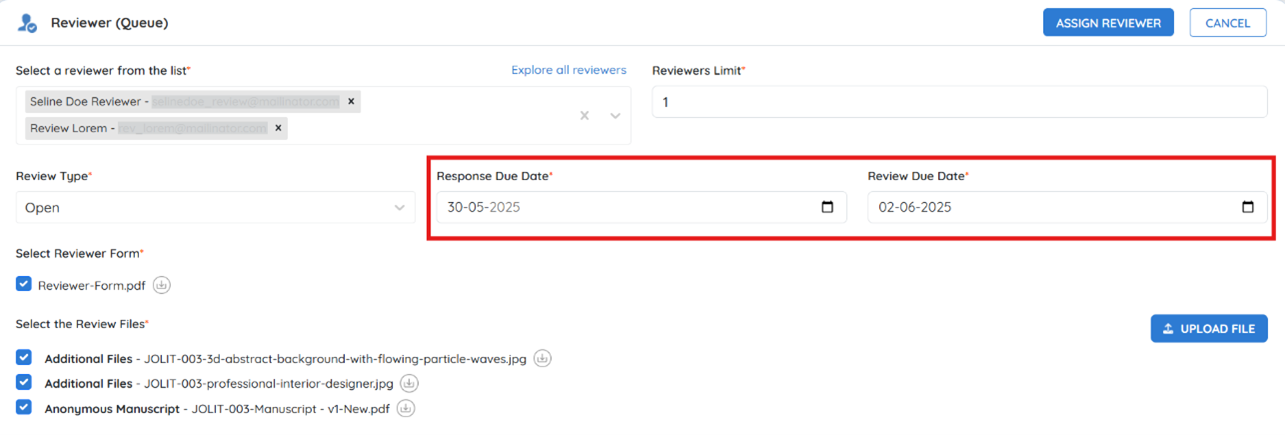
Define key dates to keep the review timeline on track
-
Response Due Date – The deadline for the reviewer to accept or decline the review request.
-
Review Due Date – The deadline for the reviewer to submit their review.
Step 7: Select Reviewer Form
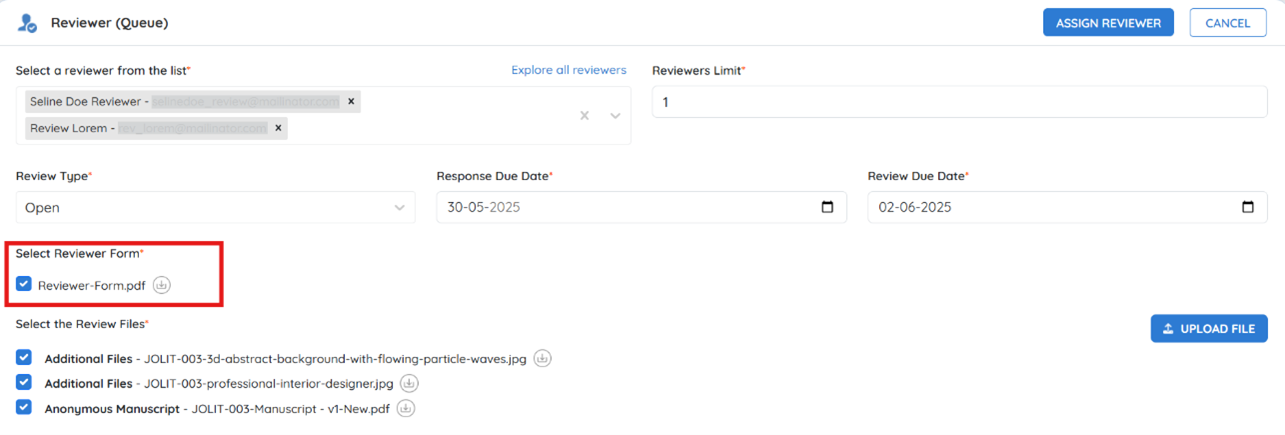
Choose the appropriate Reviewer Form that the reviewer will use to evaluate the manuscript. This form typically includes:
- Evaluation questions
- Rating scales
- Sections for written feedback to the author and editor
Step 8: Select Review Files
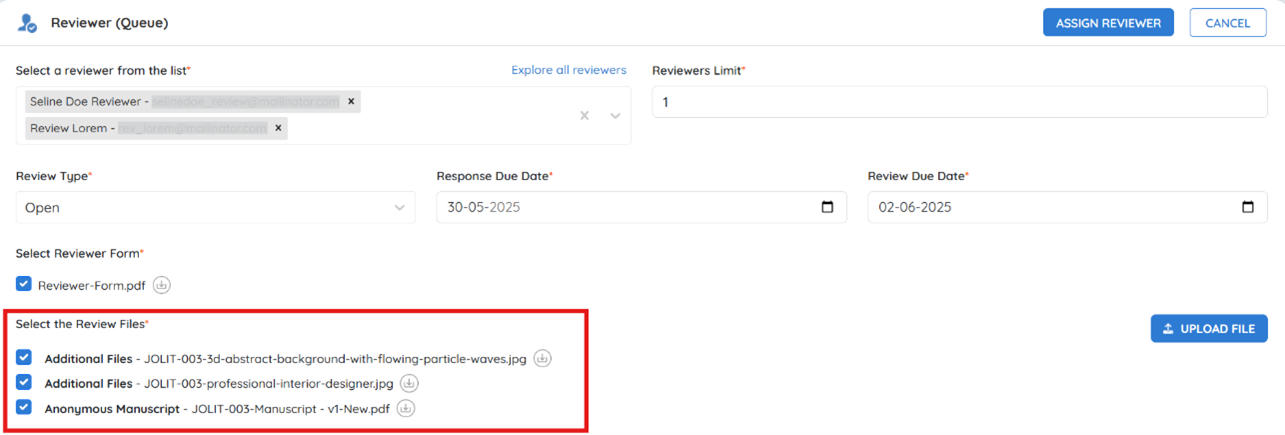
- Choose the manuscript and any additional documents the reviewer needs for evaluation.
Step 9: Add a Message

- Include a message to the reviewer with specific instructions or guidelines.
Final Step: Submit the Review Request
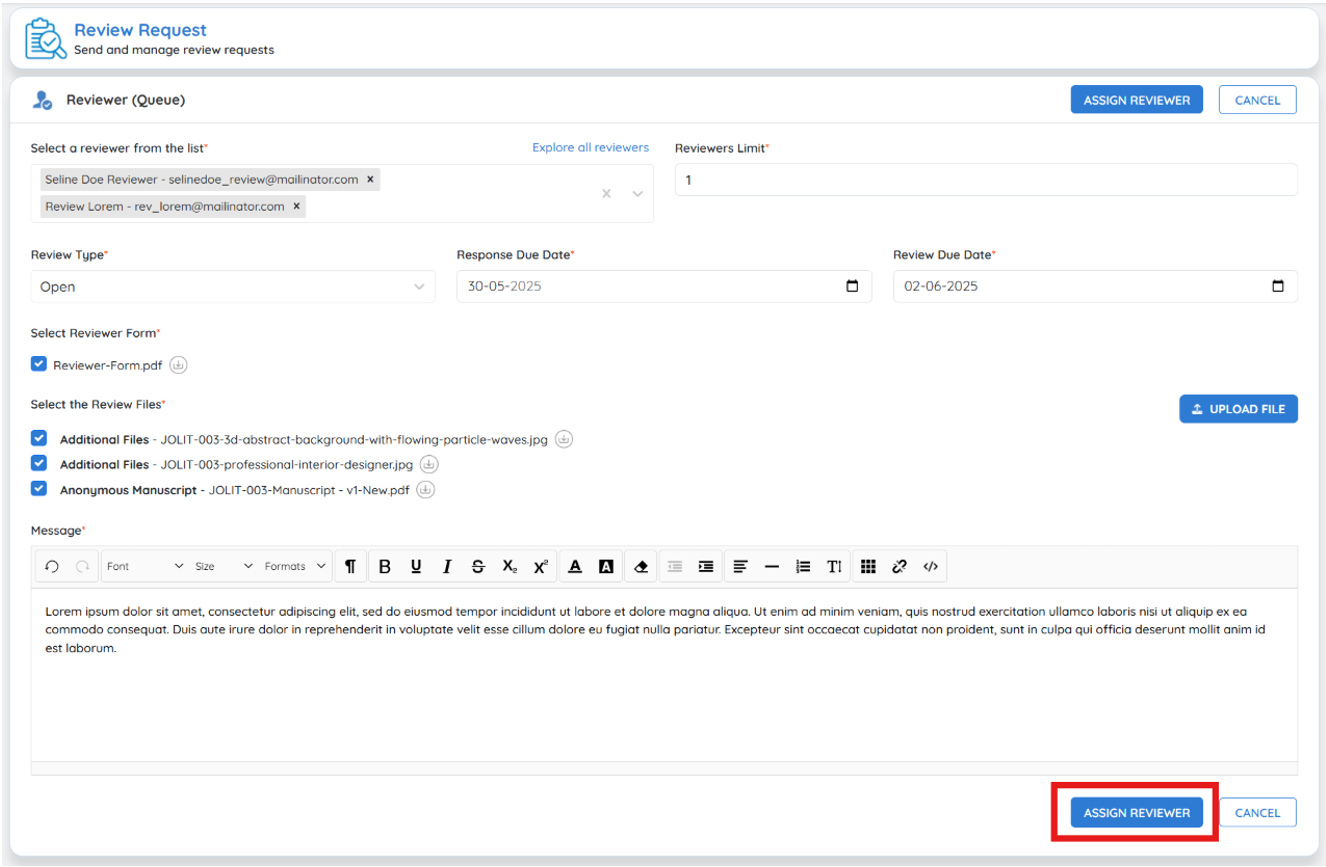
Click “Assign Reviewer” to finalize the assignment.
- The selected reviewer will receive an automated email notification with all assignment details.
- The system will update their status to reflect the active invitation.
- The review queue will now show this reviewer as “Invited” with their deadlines and progress trackable.
Now all the reviewer is assigned.
Reviewer Assignment Options
Kryoni JMS provides flexible methods to assign reviewers to a manuscript, ensuring that editorial users can manage review workflows efficiently and with full control.
Option 1: Edit Existing Queue
If you've already created a review queue and want to add more reviewers to it:
- Click “Edit Existing Queue” from the +Add Reviewer dropdown.
- Select a reviewer from the list.
- Set the Response Due Date – the deadline for the reviewer to accept or decline the invitation.
- Set the Review Due Date – the deadline for the reviewer to submit their evaluation.
Use this option when continuing an ongoing review phase without creating a new queue.
Option 2: Create New Queue
If you're starting a second phase of review or want to isolate reviewer sets, click “Create New Queue.”
- You can set a new reviewer limit specific to this queue.
- Useful for resubmissions, multiple review rounds, or editorial segmentation.
Option 3: Add Individual Reviewer
Use this option when you want direct control over reviewer assignment.
-
Click “Add Individual Reviewer.”
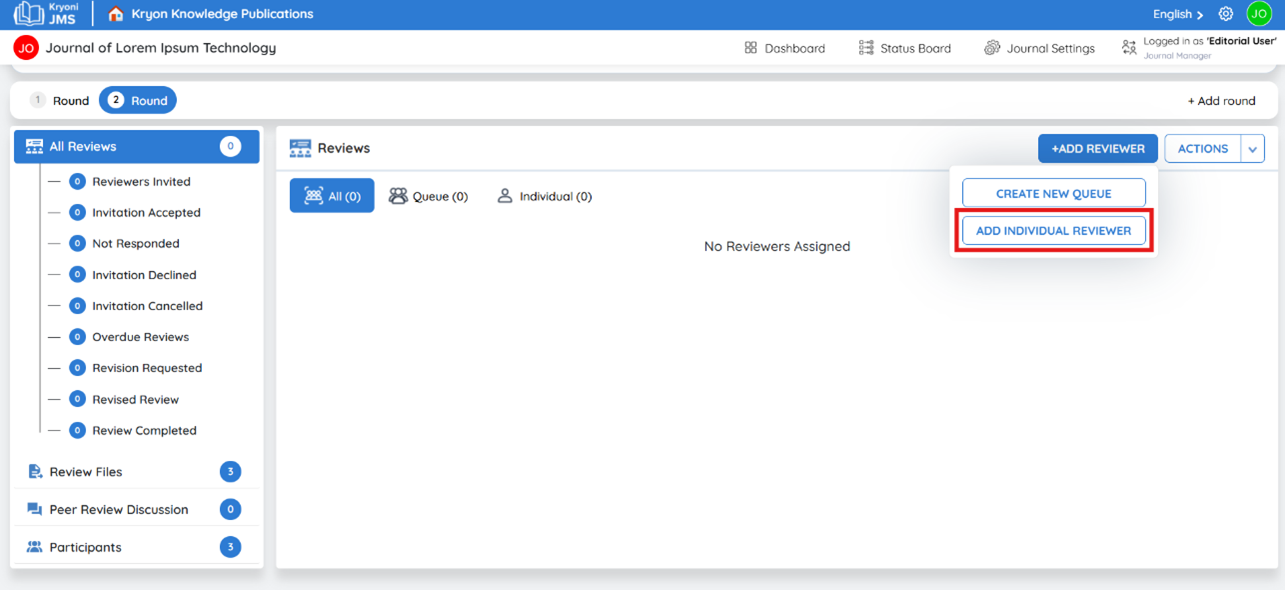
-
Select a specific reviewer with the right expertise.
-
Assign Response and Review Due Dates.
-
Send a personalized review invitation.
Ideal for high-priority manuscripts or when a specific reviewer’s input is essential.
Why Use "Add Individual Reviewer"?

- Manual selection gives you complete control.
- Best suited for targeted or high-value assignments.
- Ensures direct delivery of the review invitation, avoiding queue rules.
Now All Reviewers Are Assigned – Understanding Review Categories
Once reviewers are assigned to a manuscript, they are categorized based on their status and the review process setup. The system ensures smooth tracking and management of each reviewer’s progress.
Reviewer Categories
1️. All Reviewers
This category displays all assigned reviewers for the manuscript, regardless of their current status.
Displayed Information
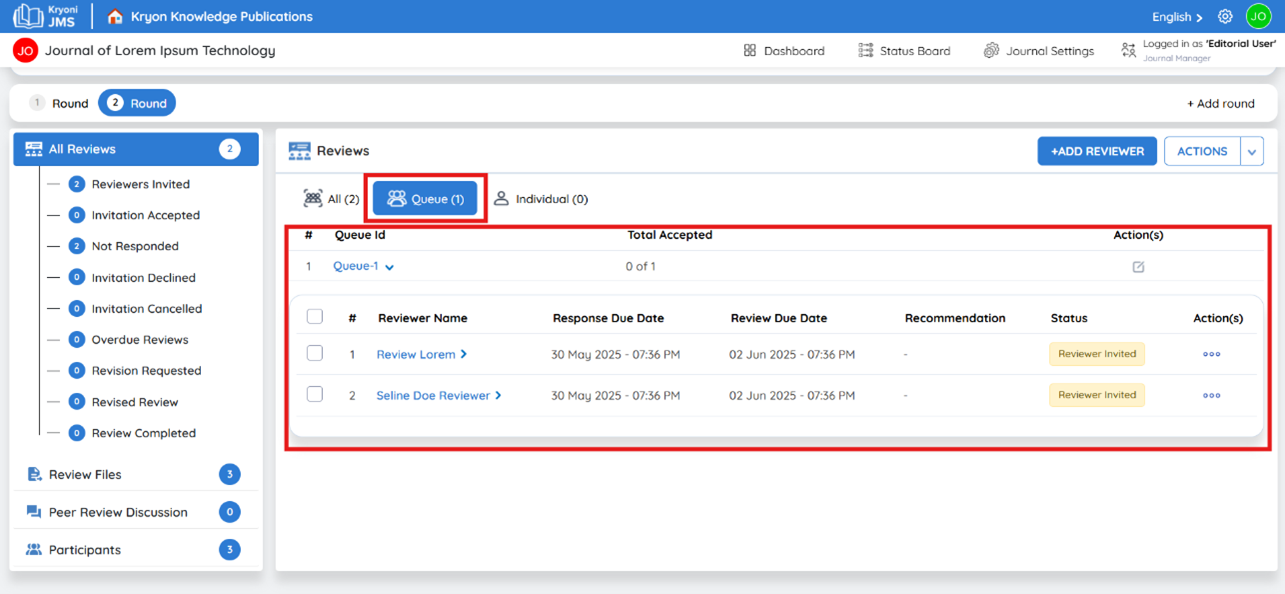
- Reviewer Name – Name of the assigned reviewer.
- Response Due Date – Deadline for the reviewer to accept the invitation.
- Review Due Date – Deadline to submit their review.
- Recommendation – Reviewer's decision (Accept, Revise, Reject, etc.).
- Status – The current stage of the review.
- Action(s) – Editors can take actions such as sending reminders or cancelling invitations.
Viewing Detailed Reviewer Information
To access additional details about an assigned reviewer, follow these steps:

Steps to View Reviewer Information
- Click on the Reviewer Name in the review list.
- A Reviewer Information Tab will open, displaying key details such as:
- Reviewer Email – The email address of the assigned reviewer.
- Type – The type of review assigned, e.g., Single-Blind, Double-Blind, or Open Review.
- Review Sent Files – Manuscript files and any supplementary materials shared with the reviewer.
- Request Review Form – The structured review form provided for the reviewer to submit feedback.
2. Queue
This category applies when a Reviewer Limit is set, meaning only a specific number of reviewers are allowed to proceed.
Queue ID and Total Accepted
Queue ID
- A unique identifier assigned to each review queue when a Reviewer Limit is set.
- Helps track and manage multiple review rounds efficiently.
Total Accepted
- Displays the number of reviewers who have accepted the invitation within the set limit.
- Once the limit is reached, remaining pending invitations are automatically cancelled.
Example Scenario
An editor is handling two different manuscripts with separate reviewer limits.
| Queue ID | Manuscript ID | Reviewer Limit | Total Accepted | Pending Invitations |
|---|---|---|---|---|
| Queue -1 | KJMS-007 | 3 | 2/3 | 2 (waiting) |
| Queue -2 | KJMS-008 | 2 | 2/2 | 0 (limit reached) |
- Queue -1 still has one more slot available before reaching the limit.
- Queue –2 has already filled its reviewer slots, so any remaining pending invitations are cancelled.
- Editors can track and manage multiple queues efficiently using Queue ID and Total Accepted reviewers.
Viewing the List of Reviewers in a Queue
To see the list of reviewers assigned to a specific Queue, follow these steps:
Steps to View Assigned Reviewers
1️. Click on the Queue Name in the Review Round Dashboard.
2️. A Queue Information Panel will open, displaying details of all assigned reviewers.
Displayed Information in Queue
| Field | Description |
|---|---|
| Reviewer Name | Name of the assigned reviewer |
| Response Due Date | Deadline for the reviewer to accept the invitation |
| Review Due Date | Deadline for submitting their review |
| Recommendation | Reviewer's decision (Accept, Revise, Reject, etc.) |
| Status | Current stage (Pending, Accepted, Completed, Overdue) |
| Action(s) | Editors can send reminders or cancel invitations |
Add Individual Reviewer
The Individual category is used when reviewers are assigned manually, without placing them in a queue or setting a Reviewer Limit. This method offers complete flexibility and is ideal for targeted assignments where specific reviewers are chosen for their expertise.
Cancelling a Reviewer Invitation
If you need to withdraw a review invitation before the reviewer responds or begins the review process, you can easily cancel the invitation using the following steps:
Steps to Cancel a Reviewer Invitation:
1. Locate the Reviewer
a. Navigate to the list of assigned reviewers under the All reviews dashboard.
2. Open the Action Menu
a. Find the reviewer whose invitation you want to cancel.
b. Click on the three-dot menu under the Action column.
3. Select "Cancel Reviewer"
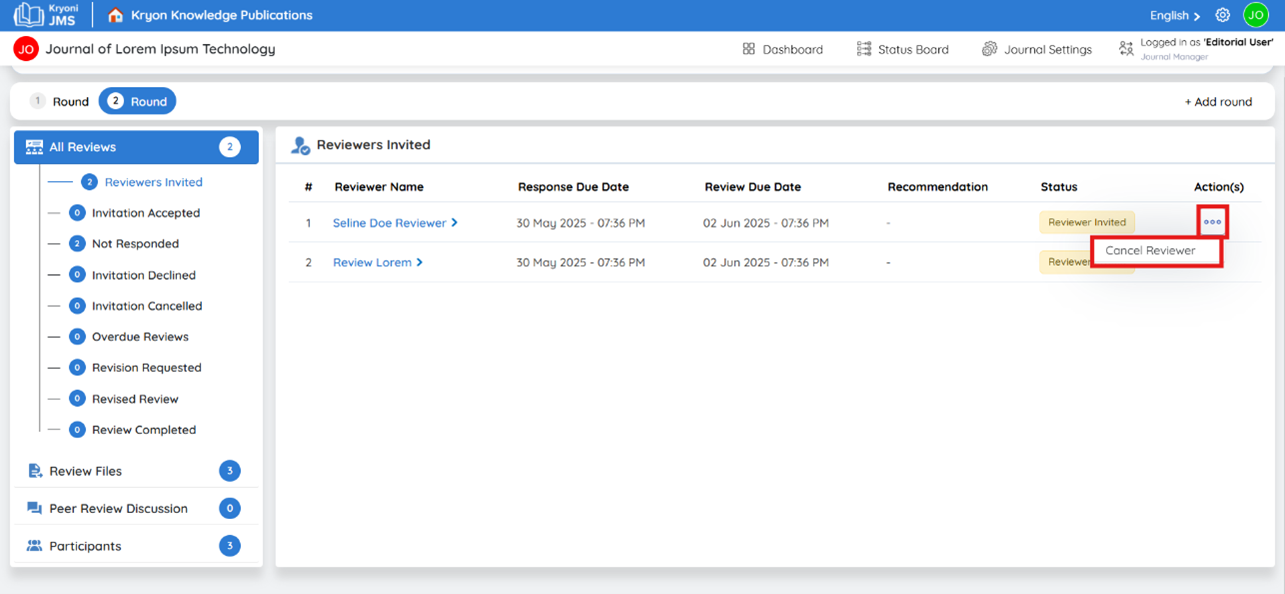
a. Click on the Cancel Reviewer option.
b. Enter Cancellation Reason
A popup window titled Cancel Reviewer will appear.
- Enter the reason for cancellation in the "Reason for Cancelling Reviewer" field (mandatory).
- Optionally, customize the message to be emailed to the reviewer.
4. Confirm the Cancellation
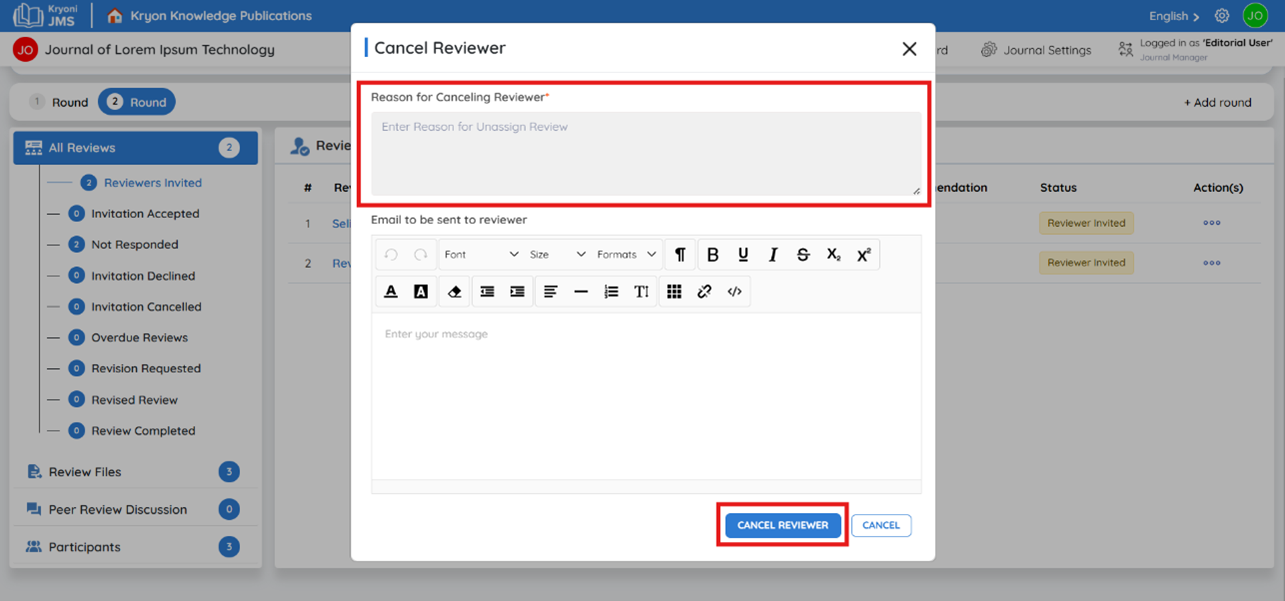
a. The review invitation will be immediately withdrawn, and the reviewer will no longer have access to the manuscript.
Key Points to Remember
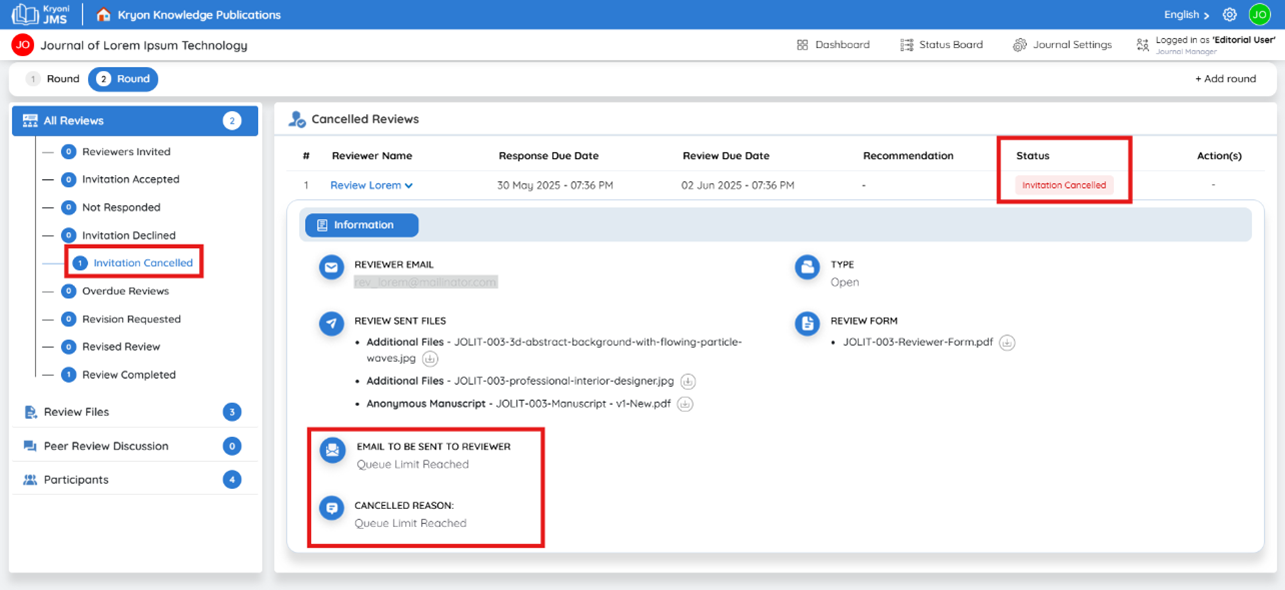
- Once cancelled, the reviewer will not be able to accept or review the manuscript.
- cancelled invitations will be recorded under Invitation cancelled in the Status Indicators.